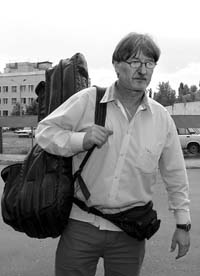Jazz Review

Kyiv Operetta has hosted the Third Yednist (Unity) International Jazz Festival commemorating noted musician Volodymyr Symonenko. It is a large, stable, life-asserting project rallying jazzmen from ex-Soviet and other countries. And it is very prestigious.
By tradition, young musicians were the first to perform: Volodymyr Pashynsky’s Darnytsia Junior Big Band on the first day, and V. Solianyk’s Gliere City Jazz on the second. Both groups are very young in terms of the musicians’ age and career, and both are on the right track, thanks to able guidance and talented performance.
As to the adult musicians, Serhiy Suprun’s quartet played professionally but failed to demonstrate an individual approach. Kharkiv’s Anno Domini trio actually performed as three separate duets. Although the soloist Maryna Zakharova made the audience happy with her flexible, soft voice and broad lyrical range, with good vocal technique, vibration, excellent diction, and timbre overtones, the trio lacked the energy for the time allocated them. After them the audience, far from packed, became even smaller. However, those that stayed were fully rewarded. Button accordionist Kostiantyn Strelchenko was at his creative best, and the audience was instantly aware of his sure hand and true quality. A mature musician, conservatory graduate, and recipient of the World Music Grand Prix in Italy last fall, he confidently placed himself among the Yednist leaders. His performance had a skilful dramatic touch to it, relying on his instruments bright genre coloration. Strelchenko is distinguished by an ironclad rhythm, clarity, outward simplicity and ease of every rendition, and flawless taste, which he combines to produce high culture. His inner musical reserve is large and diverse, serving as the basis of his self-expression. He plays on a vast range, marked by a variety of timbres, overtones, dynamics, and techniques. He pulled off some intonation tricks that sounded almost risque, but never crossed the line. This author had heard him previously, but Kyiv marked his moment of glory.
The first day ended with Igor Bryl, one of the Best Russian jazz pianists, People’s Artiste of Russia, professor, and head of the jazz art chair at the Gnesin Institute (Moscow), with his sax-playing twin sons Dmitry (soprano) and Aleksandr (tenor). Actually, all three were very much alike. Their mastery is well know in Ukraine and they are very respected here. They were their usual virtuoso selves, and their orchestration, tested and polished over the years, sounded too good to be true. No one playing in the mainstream style here can challenge them.
The next day the audience was three times its previous size. Pianist Volodymyr Solianyk’s Kyiv Art Ensemble turned in an interesting performance with three guest musicians: Armen Kostandjan from Yerevan, playing the duduk, an exotic Armenian wind instrument; Getz Grunberg (soprano sax) from Cologne, appearing at the festival for the first time; and the nonetheless exotic Tyvan Nikolai Oorzhak doing guttural singing and playing the igile, a folk string-and-bow instrument unknown in Ukraine. The ensemble’s opening number (without guests) was a large pseudo-avant-garde composition, using an exceptionally expositional material, which turned out too complicated to be fully developed. Instead, they did a series of fragments glued together. Hryhory Nemyrovsky’s flugelhorn sound beautifully soft and lyrical. After all, the group had never before attempted this complex style, it was their piece (its eclectic character prompted one to title it Patchwork Quilt), so all one can say is Godspeed. The rest of the program was generally kept at the traditional medium level. The German musician played very well, producing a marvelous energetic sound due to a remarkably powerful breathing, excellent technique, and wild temperament. The small duduk-player and the Tyvan with a vocal range reminding one of Yma Sumac, a totally inexplicable manner of rendition, capable of producing chords rather than tunes, were greeted with an ovation.
The next to appear onstage was the gorgeous vocal sextet Mansound. A group of world caliber made up of highly educated and professional soloists, including teachers of the Tchaikovsky Academy. In fact, this author believes that their vocal level is higher than that of Take Six and Manhattan Transfer, especially when they perform Ukrainian songs. Their strongest emotional number was Tolmachov’s It’s Not a Blizzard on the Meadow, a symphony for six voices kept in the best traditions of Mykola Leontovych, followed by group leader Volodymyr Mykhnevsky’s luxurious arrangements of Ukrainian songs. Their arts penetrates one’s heart, bringing tears to one’s eyes and the audience to ecstasy. They were fantastic!
The last to perform was Enver Izmailov, People’s Artiste of Ukraine, an acknowledged master of ethnojazz and virtuoso guitarist, showing his best. Also of world caliber, his repertoire consists of remarkably expressive time-tested compositions that never fail to conquer the listeners. As usual, he was in fine shape, friendly, and outspoken. And the final chord was a small jam session with Solianyk, Izmailov, Nemyrovsky, Voichenko, and Oorzhak. It was great!
Ukrainian jazz is evolving, growing wiser and more professional, leaning more to the philharmonic side, ceasing to be a purely bar and club entertainment (although this author finds nothing wrong with that). Such festivals play an important role in the process. As for the organizers, they ought to allocate the same temporary quota only for mature professionals, while helping young (and not so young) performers assess their potential, so they could show off their best numbers.






